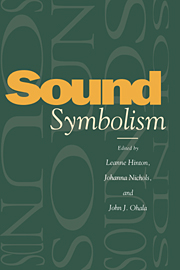Crossref Citations
This Book has been
cited by the following publications. This list is generated based on data provided by Crossref.
Yorkston, Eric
and
Menon, Geeta
2004.
A Sound Idea: Phonetic Effects of Brand Names on Consumer Judgments.
Journal of Consumer Research,
Vol. 31,
Issue. 1,
p.
43.
Ibarretxe-Antuñano, Iraide
2004.
Language typologies in our language use: The case of Basque motion events in adult oral narratives.
cogl,
Vol. 15,
Issue. 3,
p.
317.
King, Ros
2007.
Reading beyond Words: Sound and Gesture inThe Winter's Tale.
Pedagogy,
Vol. 7,
Issue. 3,
p.
385.
Philps, Dennis
2008.
Introduction.
Lexis,
Philps, Dennis
2008.
Introduction.
Lexis,
Zuidema, Willem
and
Verhagen, Arie
2010.
What Are the Unique Design Features of Language? Formal Tools for Comparative Claims.
Adaptive Behavior,
Vol. 18,
Issue. 1,
p.
48.
Nuckolls, Janis B.
2010.
The Sound-Symbolic Expression of Animacy in Amazonian Ecuador.
Diversity,
Vol. 2,
Issue. 3,
p.
353.
Wichmann, Søren
Holman, Eric W.
and
Brown, Cecil H.
2010.
Sound Symbolism in Basic Vocabulary.
Entropy,
Vol. 12,
Issue. 4,
p.
844.
Contini, Michel
2010.
Les phonosymbolismes : continuité d'une motivation primaire ?.
Travaux de linguistique,
Vol. n° 59,
Issue. 2,
p.
77.
Berto, Flávia de Freitas
and
Mori, Angel Corbera
2011.
Léxico y categorização etnobiológica en grupos indígenas del Gran Chaco..
LIAMES: Línguas Indígenas Americanas,
Vol. 11,
Issue. 1,
p.
187.
Al-Azzam, Bakri
and
Al-Kharabsheh, Aladdin
2012.
Jordanian Folkloric Songs in Translation: Mousa’s Song They Have Passed by Without a Company as a Case Study.
Meta,
Vol. 56,
Issue. 3,
p.
557.
Pitcher, Benjamin J.
Mesoudi, Alex
McElligott, Alan G.
and
Cameron, Elissa Z.
2013.
Sex-Biased Sound Symbolism in English-Language First Names.
PLoS ONE,
Vol. 8,
Issue. 6,
p.
e64825.
WATANABE, Junji
KANO, Arisa
and
SAKAMOTO, Maki
2014.
Trend Visualization of Emotional Judgments on Materials in Contact Using Distribution Map of Japanese Onomatopoeic Words.
Transactions of Japan Society of Kansei Engineering,
Vol. 13,
Issue. 2,
p.
353.
Perlman, Marcus
and
Cain, Ashley A.
2014.
Iconicity in vocalization, comparisons with gesture, and implications for theories on the evolution of language.
Gesture,
Vol. 14,
Issue. 3,
p.
320.
Carling, Gerd
and
Johansson, Niklas
2014.
Motivated language change: processes involved in the growth and conventionalization of onomatopoeia and sound symbolism.
Acta Linguistica Hafniensia,
Vol. 46,
Issue. 2,
p.
199.
Kanero, Junko
Imai, Mutsumi
Okuda, Jiro
Okada, Hiroyuki
Matsuda, Tetsuya
and
Nishijo, Hisao
2014.
How Sound Symbolism Is Processed in the Brain: A Study on Japanese Mimetic Words.
PLoS ONE,
Vol. 9,
Issue. 5,
p.
e97905.
Gwóźdź, Maja
2014.
Phonaesthetic Phonological Iconicity in Literary Analysis Illustrated by Angela Carter’s “The Bloody Chamber”.
Analyses/Rereadings/Theories: A Journal Devoted to Literature, Film and Theatre,
Vol. 2,
Issue. 2,
p.
1.
Guevremont, Amelie
and
Grohmann, Bianca
2015.
Consonants in brand names influence brand gender perceptions.
European Journal of Marketing,
Vol. 49,
Issue. 1/2,
p.
101.
Sakamoto, Maki
and
Watanabe, Junji
2016.
Cross-Modal Associations between Sounds and Drink Tastes/Textures: A Study with Spontaneous Production of Sound-Symbolic Words.
Chemical Senses,
Vol. 41,
Issue. 3,
p.
197.
Dias, Luís
and
Dias, Alexandra
2017.
“Language Is the Place from Where the World Is Seen”—On the Gender of Trees, Fruit Trees and Edible Fruits in Portuguese and in Other Latin-Derived Languages.
Languages,
Vol. 2,
Issue. 3,
p.
15.



